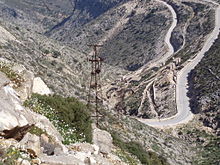Emery (rock)
This article needs additional citations for verification. (April 2010) |

Emery is a dark granular rock used to make abrasive powder. It largely consists of the mineral corundum (aluminium oxide), mixed with other species such as the iron-bearing spinels hercynite and magnetite, and also rutile (titania). Industrial emery may contain a variety of other minerals and synthetic compounds such as magnesia, mullite, and silica.
It is black or dark grey in colour, less dense than translucent-brown corundum with a specific gravity of between 3.5 and 3.8. Because it can be a mixture of minerals, no definite Mohs hardness can be assigned: the hardness of corundum is 9 and that of some spinel-group minerals is near 8, but the hardness of others such as magnetite is near 6.
Crushed or naturally eroded emery (known as black sand) is used as an abrasive — for example, on an emery board and emery cloth, as a traction enhancer in asphalt and tarmac mixtures.
Turkey and Greece are the main suppliers of the world's emery. These two countries produced about 17,500 tonnes of the mineral in 1987.[1]
The Greek island of Naxos used to be the main source of this industrially important rock type. It has been mined on the eastern side of Naxos for well over two thousand years until recent times. However, demand for emery has decreased with the development of sintered carbide and oxide materials as abrasives.
A small quantity of emery is used in coated abrasive products, but its main use in the United States is wear-resistant floors and pavements.[2] Many tonnes are reportedly shipped to Asia to be used in grinding rice.[3]
See also
References
- ^ Austin, G. T. (1987). Minerals Yearbook, Volume 1. pp. 71–84.
- ^ Kroschwitz], [executive editor, Jacqueline I. (2004). Kirk-Othmer encyclopedia of chemical technology (5th ed. ed.). Hoboken, N.J.: J. Wiley. p. 10. ISBN 9780471484943.
{{cite book}}:|edition=has extra text (help);|first=has generic name (help)CS1 maint: multiple names: authors list (link) - ^ Harbin., P. (November 1978). Ind. Min.: 49–73.
{{cite journal}}: Missing or empty|title=(help)
External links
- Oberg, Erik; Jones, Franklin D.; Horton, Holbrook L.; Ryffel, Henry H. (2000), Machinery's Handbook (26 th. ed.), New York: Industrial Press Inc., ISBN 0-8311-2635-3
- CDC - NIOSH Pocket Guide to Chemical Hazards
